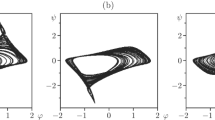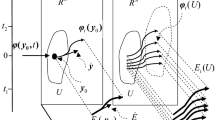Abstract
The chaotic hypothesis has several implications which have generated interest in the literature because of their generality and because a few exact predictions are among them. However its application to Physics problems requires attention and can lead to apparent inconsistencies. In particular there are several cases that have been considered in the literature in which singularities are built in the models: for instance when among the forces there are Lennard-Jones potentials (which are infinite in the origin) and the constraints imposed on the system do not forbid arbitrarily close approach to the singularity even though the average kinetic energy is bounded. The situation is well understood in certain special cases in which the system is subject to Gaussian noise; here the treatment of rather general singular systems is considered and the predictions of the chaotic hypothesis for such situations are derived. The main conclusion is that the chaotic hypothesis is perfectly adequate to describe the singular physical systems we consider, ıe deterministic systems with thermostat forces acting according to Gauss' principle for the constraint of constant total kinetic energy (“isokinetic Gaussian thermostats”), close and far from equilibrium. Near equilibrium it even predicts a fluctuation relation which, in deterministic cases with more general thermostat forces (ıe not necessarily of Gaussian isokinetic nature), extends recent relations obtained in situations in which the thermostatting forces satisfy Gauss' principle. This relation agrees, where expected, with the fluctuation theorem for perfectly chaotic systems. The results are compared with some recent works in the literature.
Similar content being viewed by others
References
L. Bertini, A. De Sole, D. Gabrielli, G. Jona-Lasinio, and C. Landim, Phys. Rev. Lett. 87:040601 (2001).
F. Bonetto, G. Gallavotti, and P. Garrido, Physica D 105:226 (1997).
F. Bonetto, G. Gentile, and V. Mastropietro, Ergodic Theory and Dynamical Systems 20:681 (2000).
E. G. D. Cohen and G. Gallavotti, J. Stat. Phys. 96:1343 (1999).
B. Derrida, J. L. Lebowitz, and E. R. Speer, Phys. Rev. Lett. 89:030601 (2002).
M. Dolowschiák and Z. Kovács, Phys. Rev. E 71:025202(R) (2005).
D. J. Evans, D. J. Searles, and L. Rondoni, Phys. Rev. E 71:056120(+12) (2005).
D. J. Evans, E. G. D. Cohen, and G. P. Morriss, Phys. Rev. Lett. 71:2401 (1993).
W. G. Hoover, Phys. Rev. A 31:1695 (1985).
G. Gallavotti, Math. Phys. Electron. J. (MPEJ) 1:1 (1995).
G. Gallavotti, J. Stat. Phys. 84:899 (1996).
G. Gallavotti, Phys. Rev. Lett. 77:4334 (1996).
G. Gallavotti, Statistical Mechanics. A Short Treatise, Springer Verlag, Berlin, 2000.
G. Gallavotti, Chaos 14:680 (2004).
G. Gallavotti, cond-mat/0402676 (2004).
G. Gallavotti, F. Bonetto, and G. Gentile, Aspects of the Ergodic, Qualitative and Statistical Theory of Motion, Springer Verlag, Berlin, 2004.
G. Gallavotti and E. G. D. Cohen, J. Stat. Phys. 80:931 (1995).
G. Gallavotti and E. G. D. Cohen, Phys. Rev. E 69:035104(R) (+4) (2004).
G. Gallavotti and E. G. D. Cohen, Phys. Rev. Lett. 74:2694 (1995).
G. Gallavotti and D. Ruelle, Commun. Math. Phys. 190:279 (1997).
N. Garnier and S. Ciliberto, Phys. Rev. E 71:060101 (2005).
G. Gentile, Forum Mathematicum 10:89 (1998).
A. Giuliani, F. Zamponi, and G. Gallavotti, J. Stat. Phys. 119:909 (2005).
J. Kurchan, J. Phys. A 31:3719 (1998).
J. Lebowitz and H. Spohn, J. Stat. Phys. 95:333 (1999).
C. Maes, J. Stat. Phys. 95:367 (1999).
S. Nosé, J. Chem. Phys. 81:511 (1984).
D. Ruelle, J. Stat. Phys. 85:1 (1996).
D. Ruelle, J. Stat. Phys. 95:393 (1999).
D. Ruelle, Turbulence, Strange Attractors and Chaos, World Scientific, New-York, 1995.
D. J. Searles and D. J. Evans, J. Chem. Phys. 113:3503 (2000).
Y. Sinai, Lectures in Ergodic Theory, Lecture notes in Mathematics, Princeton University Press, Princeton, 1977.
Y. Sinai, Russian Math. Surv. 27:21 (1972).
R. Van Zon and E. G. D. Cohen, Phys. Rev. E 69:056121(+14) (2004).
R. Van Zon and E. G. D. Cohen, Phys. Rev. Lett. 91:110601(+4) (2003).
R. Van Zon, S. Ciliberto, and E. G. D. Cohen, Phys. Rev. Lett. 92:130601(+4) (2004).
F. Zamponi, F. Bonetto, L. F. Cugliandolo, and J. Kurchan, J. Stat. Mech.: Theory Exp. P09013 (2005).
F. Zamponi, G. Ruocco, and L. Angelani, J. Stat. Phys. 115:1655 (2004).
Author information
Authors and Affiliations
Corresponding author
Additional information
PACS: 47.52.+j, 05.45.-a, 05.70.Ln, 05.20.-y
Rights and permissions
About this article
Cite this article
Bonetto, F., Gallavotti, G., Giuliani, A. et al. Chaotic Hypothesis, Fluctuation Theorem and Singularities. J Stat Phys 123, 39–54 (2006). https://doi.org/10.1007/s10955-006-9047-5
Received:
Accepted:
Published:
Issue Date:
DOI: https://doi.org/10.1007/s10955-006-9047-5




